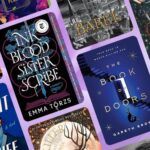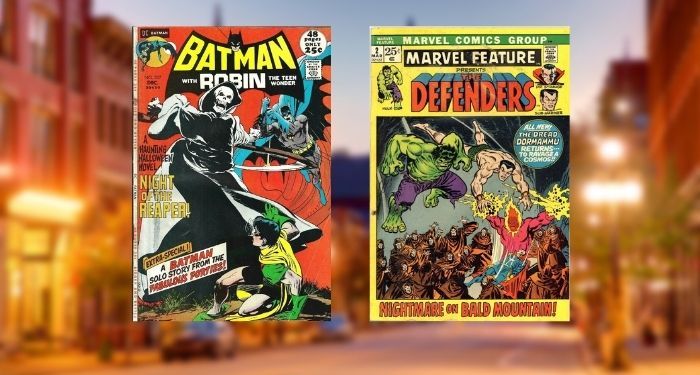
Marvel, DC, and…the Rutland, Vermont Halloween Parade?
Interactions between DC and Marvel characters are rare, for obvious reasons. Batman is not going to team up with the X-Men; Spider-Man is not going to swing by the Daily Planet to see if Perry White is hiring. Really, the only places you’re likely to see your favorite cross-company superheroes interacting are a few very rare and extremely carefully negotiated crossover events; Archive of Our Own; and Rutland, Vermont.
Wait, what was that last one?
The small city of Rutland, Vermont (population: 15,851), has a Halloween parade every year. That’s not unusual. People dress up as superheroes. That’s not unusual, either.
But for much of the ’70s, not only did comic book creators regularly travel up to Vermont to attend the parade, but the parade itself made frequent appearances in comics by Marvel, DC, and others, complete with sneaky crossovers.
Now, bear in mind that both publishers were based in New York City at the time, and New York very much has its own Halloween parade — the world’s largest, in fact, although it only began in 1973. But once it began, comics creators could have attended it for no more than subway fare. So why bother busing it all the way up to Rutland?
Blame it on Tom Fagan. Fagan, a Rutlandian, was also a huge comics fan. After the first parade in 1959 was kind of a flop, Fagan decided it should have a theme, and that theme should be superheroes. Also, Batman should be the grand marshal, since bats, Halloween, night…you get the idea.
But Fagan wasn’t just satisfied with dressing as Batman every October 31st. He began writing letters, first to Detective Comics and then to other comics, promoting the parade. He also befriended a number of comic book creators, who started making the trek up to the Green Mountain State to check this parade out.
One of those creators was Roy Thomas, who at the time was the writer of Avengers. And so, in Avengers #83 (December 1970), Earth’s Mightiest Heroes took a little jaunt up north. (If that date looks odd to you, keep in mind that comics were cover-dated two months in advance to keep them looking current on the newsstands for longer, so a “December 1970” comic would have been published in October.)
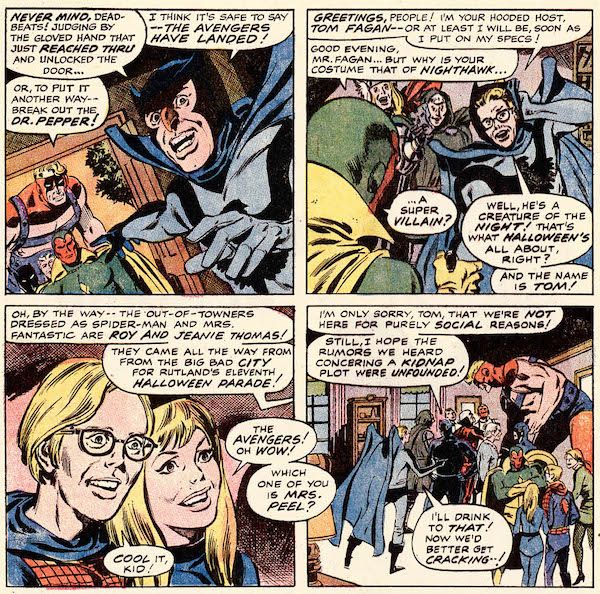
Not only do we get Rutland and Tom Fagan, but Thomas even put himself (drawn not very flatteringly by John Buscema) and his wife in the comic. In real life, Fagan usually dressed as Batman, but Thomas was evidently skittish about including the Dark Knight this early on, so he has Fagan dressed as Nighthawk instead, an evil analog to Batman whom Thomas had created for an earlier Avengers storyline. I have no explanation for why he’s written his wife so condescendingly, though.
The Avengers march in the parade, but then the Masters of Evil attack, and that’s about it as far as Halloween, Rutland, or superhero cosplay goes in this issue. Still, the gauntlet was thrown down. Would DC pick it up? After all, the parade’s grand marshal was really Batman, not Nighthawk…
They sure would. The next year brought Batman #237 (December 1971), by Dennis O’Neil and Neal Adams. This one is probably the most interesting Rutland story, but I’m not going to do a deep dive into it — for that, you’ll have to keep your eyes peeled tomorrow for Eileen Gonzalez’s coverage.
But the short version is that Dick Grayson, a.k.a. Robin, the Boy Wonder, takes a trip up to Rutland with his “roommates”: DC creators Bernie Wrightson, Gerry Conway, and Alan Weiss. Daringly, Weiss is depicted as being high as a kite for pretty much the whole issue; even more daringly, the parade floats show parade-goers dressed as Captain America, Havok, and Quicksilver. Later panels also show Thor and Spider-Man partying.
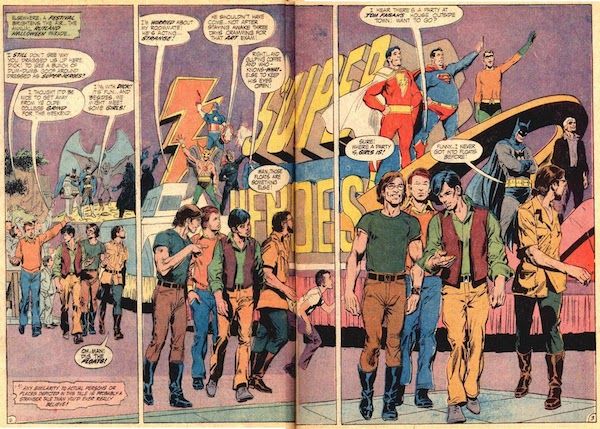
The story also tackles the Holocaust and Nazi war criminals, making it sort of all over the place in tone: stoned creator cameos and sneaky Marvel crossovers don’t really fit with one of the greatest atrocities in living memory. But it sure is a fascinating relic.
But, of course, Marvel was not to be left out. Marvel Feature #2 (March 1972, and please just trust me that this also came out in October 1971), again by Roy Thomas with Ross Andru on pencils, has the Thomases making another trek up to Vermont for the annual Halloween parade. But the Rutland gimmick arguably peaked in the fall of 1972, when DC and Marvel published an actual crossover set at the parade. Well, sort of:
- In Amazing Adventures #16 by Steve Englehart and Marie Severin, Englehart and his friends Gerry Conway and Len and Glynis Wein are driving up to Rutland when they stop to give a ride to the Beast and his girlfriend. At the end of the story, the Juggernaut attempts to steal Englehart’s car.
- Then, in Thor #206-207 by Gerry Conway and John Buscema, the same group of creators are concerned by how out of it their host Tom Fagan appears — though little do they suspect it’s because he’s been possessed by Loki. At the end of the story, an unseen figure steals Englehart’s car, and a blinded Loki chases after the sound and, uh, falls off a cliff to his apparent death. (He gets better.)
- Finally, in Justice League #103 by Len Wein and Dick Dillin, the same four creators travel to Rutland and meet the JLA, who have arrived to thwart a sinister occult plot by the evil magician Felix Faust. Faust tries to escape by — you guessed it — stealing Englehart’s car. (He’s immediately caught by the police. No word on whether they charged him with causing Loki’s fakeout death.)
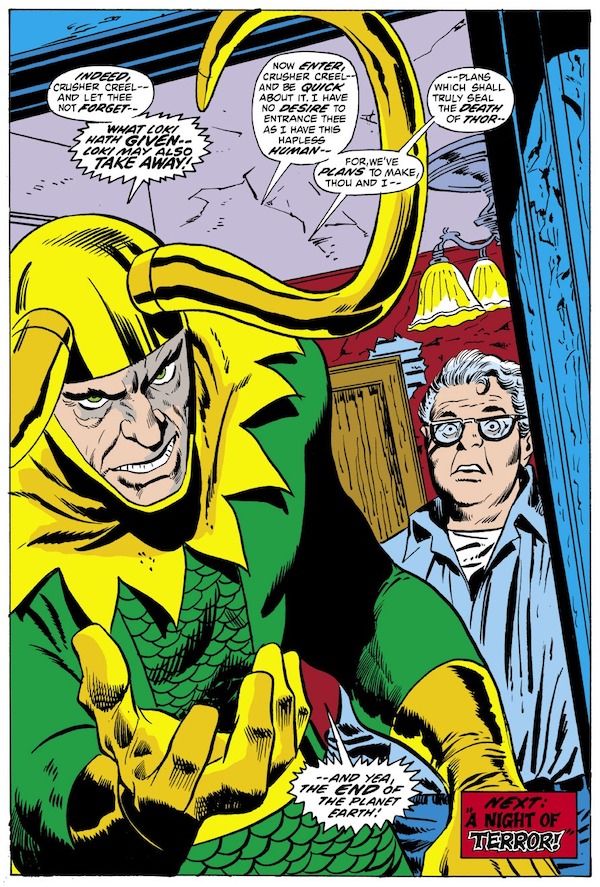
These are three distinct stories — the foursome arrives in Rutland three separate times, and Fagan is dressed as Batman in JLA and Nighthawk in the Marvel comics. But the writers still snuck in a little connective tissue between all three stories, besides the runner about Englehart’s car: Glynis Wein* is the only one of the four creators in costume, and in all three stories she’s dressed as Supergirl.**
Rutland stories continued through the ’70s and early ’80s, and there are even a couple of scattered references in the ’90s, but 1972 was definitely the peak. But aside from the weird historical novelty of it all, who cares?
To me, the Rutland stories are fascinating because they’re such a good example of a very specific time in comics when creators were regularly inserting themselves into the story. Tom Fagan’s Halloween parade was by no means the only excuse creators found to get in on the hijinks. In one memorable 1975 story (note: “memorable” does not mean “good”), the JLA gets stranded in our world and needs the help of their editor, Julius Schwartz, to get back home. Marvel heroes basically couldn’t walk down the street (or web-sling above it, as the case might be) without bumping into Stan Lee.
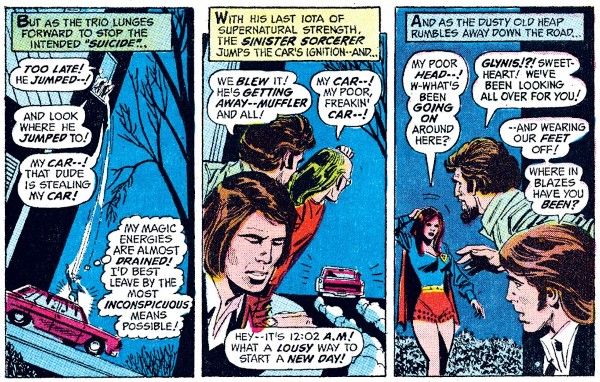
It’s Lee, who we can probably blame for this gimmick. After all, he was making cameos in comics as early as 1940, when he was just Marvel’s teenage wunderkind. When he and Jack Kirby revolutionized comics in the 1960s, a huge part of Lee’s genius was branding himself, and then the rest of the Marvel bullpen (but always himself first and foremost), as an endearing cross between celebrities, pals, and the butt of the joke. There were nicknames for everyone, from Stan “The Man” Lee to Jack “King” Kirby (the Wikipedia list of bullpen nicknames is truly something); there were short humor strips set in the office that depicted Marvel as a chaotic but fun place to work and running gags about the specific quirks of various creators. Let DC be polished and austere. Just like Marvel heroes were engagingly flawed, Marvel creators were real people you could hang out with — who also happened to have the coolest jobs in the world. (And then, of course, DC copied Marvel because what’s good for the Spider-Goose is good for the Super-Gander.)
Sometimes, when handled with restraint, this kind of playful self-insert can be charming, like when Stan and Jack are kicked out of Mister Fantastic and the Invisible Woman’s wedding. Most of the time, though, it comes across as kind of self-involved and embarrassing — as the kids would say today, cringe. At the end of the day, I’m buying a superhero comic to read about superheroes, not the people writing and drawing the superheroes. And the more you know about the real behind-the-scenes of some of these examples, the more cringe it gets. It’s hard to read Schwartz as an avuncular, self-effacing everyday hero when you know he had a habit of groping young female employees, you know?
So, where do the Rutland stories sit on that spectrum? I’d say somewhere in the middle. No offense to the late Tom Fagan, but he is not really interesting enough to have as much page time over the years as he does. The 1972 stories, in particular, spend altogether too much time on the zany shenanigans of our four creators, and the way these men write about Jean Thomas and Glynis Oliver has not aged well in the slightest.
On the other hand, it is such a specific phenomenon that I can’t help but be fascinated by it. The early ’70s were also a time of boundary-pushing in the industry, and it’s interesting to see these creators testing what they could and couldn’t depict: not just themselves but characters from the distinguished competition, recreational drug use, and even (though a tonal mismatch) the Holocaust.
Mostly, it’s evident that everyone involved was having such a dang good time (except maybe Loki), and that’s always fun to read. It’s cringe, but it’s whole-hearted cringe, and isn’t that the least cringey thing of all?
So this Halloween, let’s don our knockoff superhero costumes, grab our friends or at least the co-workers we like the best, and embrace cringe. And if you’re traveling up to Rutland, Vermont, for god’s sake, lock your car.
*Glynis Wein, who returned to her maiden name of Oliver after divorcing Len, was a creator in her own right and won a Shazam Award for Best Colorist in 1973.
**Well, in the Marvel books, she’s wearing a “G” logo instead of the famous S shield. In general, DC was slightly more daring with the crossover; the Marvel books don’t have anyone in a DC costume besides Glynis’s off-brand Supergirl, but JLA has a Spider-Man and a Captain America, though he refers to himself as “Commando America.”








